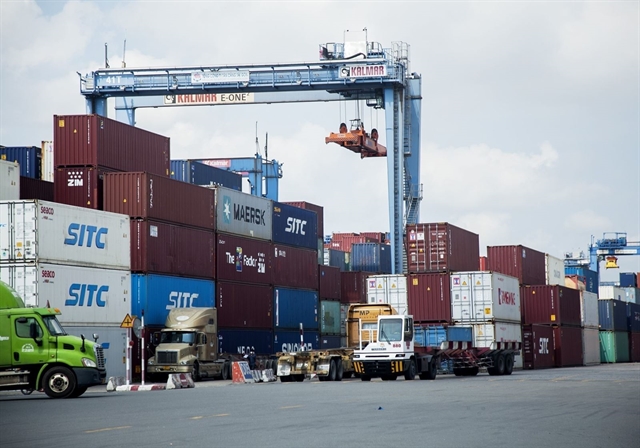Beside green logistics, digital logistics will serve as key levers to help businesses optimise costs, improve competitiveness and expand markets.

Compiled by Thu Trà
HÀ NỘI — Việt Nam's logistics industry is undergoing a transformation, shifting from traditional logistics operations to a high-tech service industry in the 4.0 era, industry experts have noted.
The General Director of LEX Vietnam Phạm Nguyễn Thanh Quang, said his firm fully integrated technologies such as artificial intelligence (AI), Big Data, IoT sensors and supply chain management systems to automate processes and enhance the user experience.
Quang said his company's AI system was implemented in stages, covering areas from order prediction and delivery line optimisation, to logistics coordination and consumer behaviour analysis.
He told a conference in Hà Nội late last week the development of digital logistics was playing a crucial soft infrastructure role in driving e-commerce growth. It enables faster and more accurate delivery, optimises operations and costs, while also boosting the profitability and competitiveness of e-commerce businesses.
Thanks to big data and AI, goods could now reach customers in remote areas, foster new business models like instant delivery, time-based delivery, and the D2C model, and support cross-border e-commerce, allowing Vietnamese businesses to quickly and effectively reach international customers, Quang noted.
According to Bùi Bá Nghiêm, Senior Expert at the Import-Export Department of the Ministry of Industry and Trade, digital logistics is one of the two strategic pillars of a modern logistics ecosystem, closely linked to the global supply chain.
Besides green logistics, digital logistics will serve as key levers to help businesses optimise costs, improve competitiveness and expand markets.
Nghiêm said that we could not discuss e-commerce, digital transformation, or green growth, if logistics was unable to keep up. Logistics companies needed to proactively transform themselves, rather than simply fulfilling the traditional logistics role.
The General Director of LEX Vietnam said Việt Nam was currently one of the fastest-growing e-commerce markets in Southeast Asia, with an annual growth rate of approximately 20 per cent. However, to sustain this growth and achieve a breakthrough, significant investment and more synchronised upgrades were needed for the logistics system.
He added that investment in logistics infrastructure remained fragmented, with a lack of regional connectivity. There was also an absence of standardisation in data and system integration between businesses, overlapping investments in warehouses leading to oversupply and price competition, and a shortage of professionally-trained human resources, making it difficult for the industry to keep pace with new technologies.
To address these challenges, Quang said, logistics companies must prioritise investments in technologies such as AI, IoT, and big data analysis systems. Strengthening collaboration between logistics units to share infrastructure and avoid redundant investments was crucial.
Additionally, developing digital logistics talent through cooperation between businesses and training institutions would be essential for long-term success, he said.
The Deputy General Director of Bắc Giang International Logistics Company, Trương Thị Mùi, suggested promoting preferential policies to encourage investment in transport infrastructure connectivity, supporting businesses in implementing Warehouse Management Systems (WMS), IoT, and AI technologies for warehouse management, and creating favourable conditions for the development of smart warehouses that meet international standards.
Việt Nam’s Logistics Performance Index (LPI) reached 3.3 points in 2023, ranking 43rd out of 154 countries and territories, and 5th among ASEAN nations.
The annual growth rate of services revenue stands at 14-16 per cent, with a market size of about US$40-42 billion per year. The quality and quantity of logistics services have improved significantly, contributing to the growth of Việt Nam's import-export turnover.
According to the Vietnam Logistics Services Development Strategy for the 2025-35 period (with a vision until 2045), logistics services are expected to contribute 6-8 per cent to GDP, with an average annual growth rate of 15-20 per cent by 2035.
Logistics costs are anticipated to drop to 12-15 per cent of GDP (down from 16-18 per cent), and Việt Nam aims to rank 35th or higher in the Logistics Performance Index (LPI) globally by 2035.
Notably, the strategy includes specific targets for 2035, such as 80 per cent of logistics businesses adopting digital transformation solutions, 30 per cent of vehicles switching to green energy and 70 per cent of workers receiving professional training, with 30 per cent holding university degrees or higher.
By 2045, logistics services are expected to contribute 12-15 per cent to GDP, with an average annual growth rate of 10-12 per cent and logistics services outsourcing reaching 80-90 per cent, while under the strategic plan, all vehicles are expected to run on green energy. — VNS





